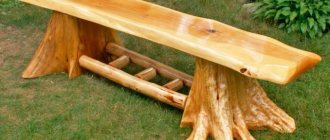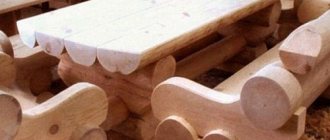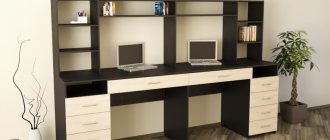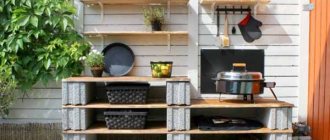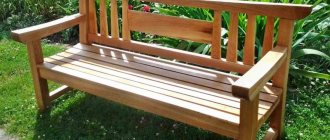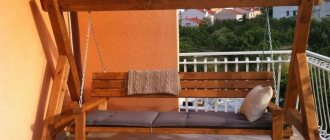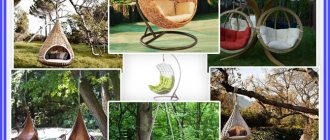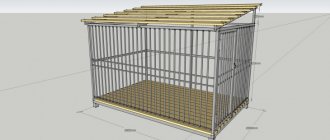A garden bench in a beautiful location surrounded by nature is an opportunity to admire the view and give your tired feet a well-deserved rest. It does not have to be of complex design or made of expensive materials. In your dacha or garden, a DIY garden bench made of wood with a back can be made from budget boards, timber and even pallets.
Types of benches
Despite the fact that there are a great many types of benches, each master brings something of his own to his creation. But according to a number of characteristics, all structures can be combined into groups.
Without back and armrests
Two supports and a board in the middle - what could be simpler. But even such a bench can be interesting and original. For production, not only standard lumber is used, but also stumps, tree trunks sawn along or across, picturesque snags, etc.
All benches without a back have a significant drawback. Sitting in tension with a straight back, you cannot completely relax and rest. Models with body support do not have this.
With backrest
More comfortable garden furniture, conducive to a long pleasant pastime. The design is complicated by additional elements. The frame of the bench includes vertical supports for attaching the backrest. They are sheathed with boards or slats.
There are a lot of solutions to these models. The slats can be filled not only lengthwise, but also across, arranged in parallel or diverging rays. The backrest can be either strictly perpendicular to the seat or slightly inclined, stationary or folding.
The simplest bench can be made from 3 thick boards. The elements of the side supports are connected with powerful bolts. The seat and backrest are secured with self-tapping screws or nails. There is nothing superfluous in the design, everything is concise and easy to implement.
With a metal frame
The load-bearing elements of the bench are made of steel, and the paneling is made of wood - a very common combination. It combines the strength and durability of metal with the comfort and warmth of wood.
Combined benches are often decorated with forging. Openwork curls, monograms, and snails give a seemingly ordinary piece of furniture a luxurious and sophisticated look.
Bench-sofa
This is a more functional option, suggesting that you can not only sit on the bench, but also lie down. The bench with a backrest can be folded out horizontally, turning into a wide sunbathing lounger.
Lying on hard boards is not very comfortable, but you can throw on blankets, pillows or mattresses with polymer filling. And if you like to read a book in the shade of the garden, make a bench with a slightly raised headrest.
With built-in table
Making such a bench is not so difficult - a small tabletop is attached to the gap cut out in the back. It can be either folding or stationary. Another working option is to combine 2 benches using a table screwed to two adjacent armrests.
Transformer
Assembling a transforming structure is somewhat more difficult. Moreover, the level of complexity depends on how many and what kind of transformations can be made.
If a bench with a reclining back turns into a lounger, this is a simple form. Dining furniture with a full-fledged table for 4-6 seats is already more complex, requiring thoughtful design solutions. All parts of the transforming bench must be manufactured strictly according to the drawings, since even a slight deviation will make the transformation impossible.
The advantages of folding systems are versatility. One such bench can replace a whole set of garden furniture. An additional plus is that folded storage does not require much space.
Children's bench
To ensure safety, changes need to be made to the design for a child - the legs should be lower and the seat narrower. The fastenings should be as strong as possible, and the bench should be stable.
The children's theme will be emphasized by finishing with multi-colored paints, bright paintings or ornaments. To avoid bruises, scratches and splinters, the surface of the wood is sanded very carefully, sharp corners are rounded.
One of the options for children's garden furniture is a bench with a box for storing sports equipment and toys. It helps to quickly deal with the mess in the area. All you need to do is cover the bottom of the frame with a batten and make a hinged lid.
And if you put the structure on rounded runners, you get a rocking bench. To avoid falling when swinging, the “skis” should be long and have a small radius of curvature.
With a plant bed
What is a garden without flowers? You can solve the problem with the help of a two-in-one bench. To plant plants, containers are collected and filled with soil.
If the seedlings are perennial and tolerate winter well, the pots are made without a bottom so that the plants live in natural conditions. As a variation - a bench integrated into an existing garden. Then the flowerbed plays the role of a decorative fence for trees or bushes.
From unplaned wood
Not only lumber processed on a machine and having a strict geometric shape can serve as a material for making a bench. Picturesque stumps, branches and snags will perfectly cope with the function assigned to them. The surface must be cleared of bark, thoroughly sanded and coated with colorless varnish with an antiseptic so as not to destroy the natural aura of the tree.
An interesting result can be obtained by intertwining sanded branches with each other. For racks, crossbars and seats, you need to take thick stems; for the back, more flexible and thin shoots are suitable.
Benches indoors
A bench as a piece of furniture is absolutely necessary in a bathhouse: they use it to change clothes, take a bath, relax after steaming, drink tea with linden blossom, dried raspberries or blueberries. Very useful, by the way. But grabbing something cold after something cold or eating something strong is a perversion that is fatal to your health.
But for the bench, the bathhouse is not a pleasure, but hard labor: every now and then there is dampness, the temperature can jump from –30 to +60 in 2-3 hours. Therefore, firstly, wood for a bath bench is required to be resistant to rotting, but without resins, tannins, salicylates, aromatic compounds and other natural chemicals. And it should only be treated with biocides made from purified mineral oils or silicone-based. Steamed skin is sensitive to substances that are harmless to it under normal conditions, and when sweat is reabsorbed, unwanted “additives” penetrate the body.
Sunbed and bench for the bath
Secondly, in a small bathhouse, where the beds won’t fit, they steam on a bench. What kind of steam is this if there is a squishing under your stomach? Therefore, the bench in the steam room is made in the form of a lounger with gaps or a grid of small slats, see fig. But even in this case, wood is required to be porous, easily absorb moisture and just as easily release it into the air.
Thirdly, the sauna bench should not contain metal parts that could be accidentally touched. The thermal conductivity of metal is high, which means it gives off heat easily. A piece of wood heated to +80 can be touched without fear, but a piece of iron at +60 (which is normal for a bathhouse) will cause a burn.
The best bath benches are made from Asian poplar tugraq. An almost complete replacement is aspen or black alder. Linden and birch are much worse; they rot easily. Silver poplar, plane tree, horse chestnut or, in the southern regions, ailanthus will last longer. All these types of wood in a bathhouse will not become slippery only if the bench dries well, for which purpose there should be no gaps in the structure that can retain moisture for a long time. And it is desirable to have the entire product easily disassembled for maintenance and, if necessary, replacement of unusable parts.
Branded shops do not meet the latter conditions and are expensive, because... made from special types of tropical wood. And a homemade bench for a bathhouse can be made no worse than a “company”, at least according to the drawing in Fig. With the thickness of the seat/lounger boards being 50 mm, its length can be increased to 2 m to allow you to steam while lying at your full height. Then the width is needed from 60 cm; it is obtained by adding a board and a pair of its heels with legs. The red arrows show the oak pads of the legs; they greatly increase their resistance to rotting.
Drawing of a homemade bench for a bathhouse
Not only for the bath
In addition to the bathhouse, benches, as mentioned at the beginning, are also returning to living quarters. And not only in a studio apartment: in a country house or in the kitchen, a bench will save a lot of space. Don’t be surprised, a bench under the wall, equivalent to a pair of chairs there, saves about 0.5 square meters. m area. And this is a small stove or corner fireplace, plus you can sleep on the bench. Of course, the appearance of a home bench should be more elegant, and it is assembled “in a furniture style”, from wood on dowels or from laminated chipboard on confirmations. A technologically simple version of a home bench for two riders is shown in Fig. It will also fit into a city kitchen if there is no room for a soft corner.
Bench for living room or kitchen
Small utility benchNote: in fig. on the right are options for making the well-known household mini-bench from available scraps. Height – at the knees; seat dimensions - according to your own fifth point.
Materials
The wood for benches must be of high quality, free from rot, knots and other defects. Poorly dried lumber is also unsuitable. Being in the open air, wood fibers periodically swell and dry out, and torsion begins. Subsequently, cracks form and fungi and insects colonize the wood, causing decay.
Ideally, lumber should be kiln dried or weather aged for at least 6 months. Such wood is freed from excess moisture, therefore it is more geometrically stable and resistant to rot than raw wood.
For garden furniture, it is recommended to use coniferous trees - pine, larch, cedar. They are resistant to rotting due to the high content of resins - natural preservatives. Oak and ash are very durable, but due to their hard, dense structure they are quite difficult to process.
In addition to edged boards, slats and beams, whole or longitudinally loose trunks, colorful stumps, thick branches and winding roots are used. It is clear that the wood needs to be well dried, sanded and impregnated with an antiseptic.
Drawings and dimensions of a garden bench made of wood with a back
Even for the simplest design, it is recommended to draw up a diagram. Then you can prepare parts of the required sizes and in the required quantity, and also calculate the need for materials.
The drawing of a garden bench with a back for two people shows that for the supporting frame you will need 8 short bars and 2 long ones, for the back frame another 2. To cover the seat and back, you need several boards 1.3 m long.
The bench with armrests has more details. For the frame you will need to prepare the front and back legs, bow, armrests, support bars, boards for the seat and back.
A bench with shaped armrests and a back made of vertical slats is assembled using dowels and screws. All parts are adjusted strictly to the dimensions in the drawing, since the dowels are installed at the ends. Of course, this is a rather labor-intensive model for a beginner, but that makes it all the more interesting to assemble.
Useful tips
We know how else you can decorate your site! We recommend reading our material on the topic – Hedge (fast-growing perennial evergreen).
Experienced craftsmen use some techniques to speed up the assembly or finishing of finished products. Let's look at some of them:
- Assembling metal benches with bolts allows , if necessary, to disassemble the structure and reuse the resulting material. At the same time, the nuts must be reliably protected from rust so that they do not have to be cut off.
- To make finishing easier, it is recommended to paint the parts before assembly . This applies to wood backs and seats attached to a metal frame, or other components that do not require welding. At a minimum, a first coat of coating is applied, although a full finishing can be done.
- When manufacturing heavy parts (concrete castings, massive welded supports for long structures), it is recommended to carry out work as close as possible to the installation site so that you do not have to carry the finished product over a long distance.
Assembly methods
Various types of fasteners are used to secure parts to each other:
- Self-tapping screws for wood. They differ from self-tapping screws for metal with a wider thread pitch. Installed in pre-drilled holes to prevent wood from splitting. The length is selected on the basis that the hardware should fit into the attached part by 1/3 of its thickness.
- Bolts. Connect two boards through a through hole. They are tightened with nuts and wide washers to prevent the wood from pressing through at the fastening point.
- Nails. Traditional fasteners for wooden structures. To avoid cracking, the rod is trimmed with pliers or filed with a file. A blunt point does not push apart, but breaks the fibers, thereby preventing the formation of cracks.
- Staples. They are U-shaped rods driven into 2 adjacent parts.
- Overlays. Fastening with perforated or serrated plates, corners, and brackets is widely used for furniture manufacturing and construction.
For external work, only corrosion-resistant fasteners are used - stainless, brass, galvanized or oxidized. It is not advisable to use black, it rusts quickly.
In carpentry, you can do without hardware at all and make connections on dowels. Wooden cylinders with a diameter of 6-10 mm are placed on glue in the prepared holes and keep the parts from moving. The adhesive composition must be intended for outdoor use.
A popular type of joining wood structures is mortise. A groove is made in one part, and a tenon is formed in the other. During installation, glue is used, and the joint is strengthened with nails or self-tapping screws.
Do-it-yourself garden bench with a wooden back: step-by-step instructions
The first stage is preparing the parts. Using a jigsaw, cut long boards for the seat to the required dimensions, and bars for the frame.
For the legs you will need 4 planks with a thickness of 3 cm and a width of 8 cm. Connect them in pairs with bars at a height of 40-50 cm from the ground. The seat boards will be attached to them, so the thickness of the bar should be at least 40-50 mm.
If the legs are slightly inclined, the ends of the boards should be filed at a slight angle. The fit to the base should be maximum to avoid vibrations and uneven loads on the frame.
Now you need to secure the seat supports. The boards are nailed to the legs at an angle of 15-20°.
In the same way, only symmetrically, assemble the opposite part of the bench frame. It is recommended to fasten parts with bolts rather than self-tapping screws. The connections work to shear, and the screws may not withstand the load.
Install a spacer made of boards between the side parts of the frame. Here you can already use self-tapping screws.
For the seat, screw 4 boards 30 mm thick and 100 mm wide to the side rails. Leave a gap of at least 10 mm between the slats to allow precipitation to drain and compensate for temperature and humidity deformations.
Assemble the backrest in the same way as the seat. Use screws for fastening.
Next, attach the slats to the sidewalls, and the armrests on them. Sand all surfaces, cover with yacht varnish, paint or oil. Place the finished bench on a flat surface.
Unusual ideas
As supports, you can use not only boards or square beams, but also rounded logs and double-edged beams. They are laid horizontally, with the bench seat on top.
You can place the cuttings of the trunks vertically and secure the seat with dowels. The design without a single nail will perfectly perform its functions. For the back, the logs are cut longer and placed close to the bench. A sanded board is fixed vertically to them. If you select the middle of a large-diameter log and smoothly trim the inner surfaces, you will get an original, authentic bench.
Is there a luxurious spreading tree growing on the site? This can be successfully played around by installing a bench in a circle near the trunk. You don't have to cut entire boards. If the old but strong pieces of wooden chairs are firmly secured to the log, the garden bench will be ready in a matter of minutes.
A lightweight design with an openwork back is what you need in a small but cozy country courtyard. You will need very little material - an unedged board, round slats and branches freed from bark. You can even use the remains from pruning garden trees.
For gatherings in the gazebo or on the veranda, corner benches are useful. If you install them near the table, you will get a spacious dining area. It will be appropriate not only in the garden, but also on the terrace or veranda.
The bench, placed on wheels, is mobile and easy to carry. Just roll it to a new place - and you won't have to lift anything heavy.
From the benches you can build a whole complex with sitting and lying areas. A large company can be accommodated here comfortably, and for a fun party it is enough to place a low table and organize refreshments.
An unusual composition of scraps of untreated trunks will add originality to any garden plot. True, you will have to try and hollow out a rounded seat with a comfortable backrest in each pair.
Armrests can be made from anything. For example, from cart wheels, as in this picture.
There is nothing unnecessary on the farm. From a couple of pallets of building materials you can make a decent, and most importantly, free bench. The pallets need to be disassembled, the slats sanded and coated with paint and varnish.
And the children too
Children's garden bench
It is known how much children love to play on benches, whether it is a noisy group of people rubbing elbows, or a whole doll world of the little mistress. As well as the fact that at the same time they fidget with enthusiasm, crawl, and, not feeling lateral support, flop. There's nothing wrong with that, it's just a child's matter. But there will be less roaring and pouting faces if the children's bench is equipped with low railings. However, it does not need a backrest, so that several shellaputs can approach both from the front and from behind, or sit astride the seat with their legs dangling.
A suitable hybrid of a bench, bench and sofa in this case is shown in Fig. It is better to place this structure near the children's playhouse. However, see what is most convenient for you, this bench is suitable in size for adults, and it is much easier to make than the previous one.
Decorative and protective treatment
Wood is the most common material for garden furniture. It is easy to process, light and durable. In terms of tactile sensations, the surface of wood is much more comfortable than metal or concrete.
As a rule, wood is treated with impregnations with an antiseptic effect, and then covered with decorative compounds - waterproof paints, enamels for exterior use, stain, yacht varnish, wax, oil. It must be taken into account that natural material does not like ultraviolet radiation and reacts to sunlight with photodestruction. Therefore, choose paints and varnishes with a UV protective component.
If you like old things with their own history, even a new bench can be turned into an antique artifact. For this purpose, artificial aging, or brushing, is used.
Soft fibers are removed from the surface of the wood with a stiff brush, and the exposed structure is emphasized with paints and varnishes. The resulting effect is very picturesque. An aged bench looks harmonious against a background of greenery and grass.
Blowtorch firing is used as a decorative and protective finish. As a result of heat treatment, wood becomes denser, increasing its resistance to moisture, rotting and mechanical damage.
Original ideas
By being creative, you can create unique landscape elements. As a material, it is easy to use old pieces of furniture, boxes or pallets, logs and branches, timber and boards.
Skills in working with metal will allow you to make original benches with a metal base.
It’s easy to add flower beds to the benches as decorative elements.
The bench surrounding the trunk of a large tree looks unusual.
As a basis for the product, you can use an old chest, the frame of a sofa, chairs or armchairs.
You can get ideas by studying photos of a do-it-yourself bench on the Internet.

